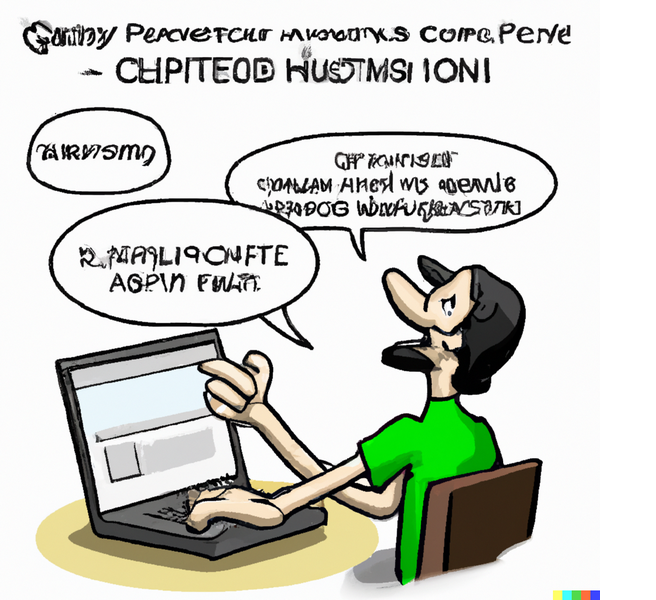 The Studious Translator, a pen-and-ink illustration inspired by Leonardo da Vinci’s style, depicts a student immersed in the world of translation and localization at a University participating in the RWS Campus academic programme. Just as the Vitruvian Man embodies the ideal human proportions outlined by the Roman architect Vitruvius, this diligent student exemplifies the harmonious balance of linguistic mastery, cultural understanding, and technical acumen required for success in the field. The drawing showcases the student in two (hidden) overlapping positions—one representing the precision of translation within a square, and another showcasing the adaptability of localization within a circle. This intriguing illustration not only highlights the student’s dedication to comprehending essential concepts but also their aspiration to innovate and refine them. Although not the first to capture the essence of translation and localization, the Studious Translator gains iconic status as a symbol of the modern Renaissance in language and technology. It serves as a testament to the interdisciplinary nature of these fields, weaving together mathematics, linguistics, and art. The original drawing is carefully preserved in a climate-controlled archive at RWS Campus, exemplifying the programme’s commitment to nurturing the next generation of translation and localization professionals.
The Studious Translator, a pen-and-ink illustration inspired by Leonardo da Vinci’s style, depicts a student immersed in the world of translation and localization at a University participating in the RWS Campus academic programme. Just as the Vitruvian Man embodies the ideal human proportions outlined by the Roman architect Vitruvius, this diligent student exemplifies the harmonious balance of linguistic mastery, cultural understanding, and technical acumen required for success in the field. The drawing showcases the student in two (hidden) overlapping positions—one representing the precision of translation within a square, and another showcasing the adaptability of localization within a circle. This intriguing illustration not only highlights the student’s dedication to comprehending essential concepts but also their aspiration to innovate and refine them. Although not the first to capture the essence of translation and localization, the Studious Translator gains iconic status as a symbol of the modern Renaissance in language and technology. It serves as a testament to the interdisciplinary nature of these fields, weaving together mathematics, linguistics, and art. The original drawing is carefully preserved in a climate-controlled archive at RWS Campus, exemplifying the programme’s commitment to nurturing the next generation of translation and localization professionals.
Continue reading “Unlocking Linguistic Success: Navigating the Path to Translation and Localization Mastery for Academia’s Rising Stars” →
 In the heart of LingoVille, translator Trina was renowned for her linguistic prowess but was a bit behind in the tech world. When her old typewriter finally gave out, she received a sleek new laptop, which came with OneDrive pre-enabled. Initially hesitant about this “cloud magic,” she soon marvelled at the convenience of securely storing her translations online, accessible from anywhere, safeguarding her precious work from life’s unpredictabilities. This modern twist turned Trina from a tech-sceptic into a cloud enthusiast overnight.
In the heart of LingoVille, translator Trina was renowned for her linguistic prowess but was a bit behind in the tech world. When her old typewriter finally gave out, she received a sleek new laptop, which came with OneDrive pre-enabled. Initially hesitant about this “cloud magic,” she soon marvelled at the convenience of securely storing her translations online, accessible from anywhere, safeguarding her precious work from life’s unpredictabilities. This modern twist turned Trina from a tech-sceptic into a cloud enthusiast overnight.





 Whilst the solving of regular expressions with ChatGPT seems like a great way to give yourself superpowers I have stayed away from writing about this usecase till now. Yes, ChatGPT is great for those simple things that anyone with some basic knowledge could probably write themselves in the time it took to explain what was wanted. But I like regular expressions… I’m definitely not a real expert, but I do like to play around with them and would consider myself above an average user. So when I decided to test ChatGPT with a regular expression I asked it to solve something I have never been able to achieve on my own. In fact I have never seen anyone else do this either… although I’m certain there are many people out there who would be very capable of doing it. But when I’ve asked I have never had a satisfactory solution without using code, or without using multiple search & replace operations.
Whilst the solving of regular expressions with ChatGPT seems like a great way to give yourself superpowers I have stayed away from writing about this usecase till now. Yes, ChatGPT is great for those simple things that anyone with some basic knowledge could probably write themselves in the time it took to explain what was wanted. But I like regular expressions… I’m definitely not a real expert, but I do like to play around with them and would consider myself above an average user. So when I decided to test ChatGPT with a regular expression I asked it to solve something I have never been able to achieve on my own. In fact I have never seen anyone else do this either… although I’m certain there are many people out there who would be very capable of doing it. But when I’ve asked I have never had a satisfactory solution without using code, or without using multiple search & replace operations. I’m sure everyone reading this is no stranger to the often completely unintelligible error messages that can be generated when software goes wrong! You can even find in the most voted for ideas in the RWS Community ideas platform that is related to just that, “
I’m sure everyone reading this is no stranger to the often completely unintelligible error messages that can be generated when software goes wrong! You can even find in the most voted for ideas in the RWS Community ideas platform that is related to just that, “ Localization engineers are the miracle workers behind the scenes of localization workflows, and without them many of the projects we see couldn’t happen. The skillsets they possess go far beyond the sort of things that most translators know how to do, and often require the ability to code. I’ve already
Localization engineers are the miracle workers behind the scenes of localization workflows, and without them many of the projects we see couldn’t happen. The skillsets they possess go far beyond the sort of things that most translators know how to do, and often require the ability to code. I’ve already  As I’m getting lost in my own thoughts around just what to talk about next with regard to AI technologies and in particular ChatGPT… and as I’m pondering about the effect this is going to have on our industry I recalled a couple of questions around the use of XPath in the community. One of these questions was yesterday and it related to how to use XPath to extract one of the languages in a TMX file using the XML filetype in Trados Studio. Not a particularly tricky thing to do, and I imagined the user was just editing the content or maybe changing the language pair by translating one of the languages into something else, or something like that. But what struck me was
As I’m getting lost in my own thoughts around just what to talk about next with regard to AI technologies and in particular ChatGPT… and as I’m pondering about the effect this is going to have on our industry I recalled a couple of questions around the use of XPath in the community. One of these questions was yesterday and it related to how to use XPath to extract one of the languages in a TMX file using the XML filetype in Trados Studio. Not a particularly tricky thing to do, and I imagined the user was just editing the content or maybe changing the language pair by translating one of the languages into something else, or something like that. But what struck me was